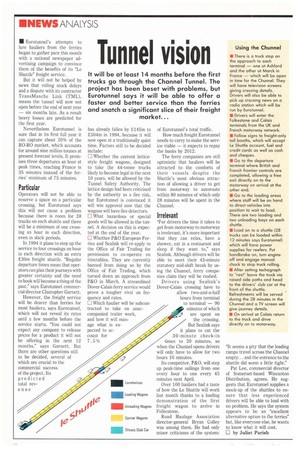Tunnel vision
Page 20

If you've noticed an error in this article please click here to report it so we can fix it.
It will be at least 14 months before the first trucks go through the Channel Tunnel. The project has been beset with problems, but Eurotunnel says it will be able to offer a faster and better service than the ferries and snatch a significant slice of their freight market...
• Eurotunnei's attempts to lure hauliers from the ferries began to gather pace this month with a national newspaper advertising campaign to convince them of the benefits of its "Le Shuttle" freight service.
But it will not be helped by news that rolling stock delays and a dispute with its contractor TransManche Link (TML), means the tunnel will now not open before the end of next year — six months late. As a result heavy losses are predicted for the first year.
Nevertheless Eurotunnel is sure that in its first full year it can capture about 20% of the RO-RO market, which accounts for around nine million tonnes at present forecast levels. It promises three departures an hour at peak times, reaching France in 35 minutes instead of the ferries' minimum of 75 minutes.
Particular
Operators will not be able to reserve a space on a particular crossing, but Eurotunnel says this will not cause a problem because there is room for 28 trucks on each shuttle and there will be a minimum of one crossing an hour in each direction, even in slack periods.
In 1994 it plans to step up the service to four crossings an hour in each direction with an extra £.30m freight shuttle. "Regular departure times mean that operators can plan their journeys with greater certainty and the need to book will become a thing of the past," says Eurotunnel commercial director Chistopher Garnett.
However, the freight service will be dearer than ferries for most hauliers, says Eurotunnel, which will not reveal its rates until a few months before the service starts. "You could not expect any company to release prices for a product it will not be offering in the next 12 months," says Garnett. But there are other questions still to be decided, several of which are crucial to the commercial success of the project. Its predicted total rev enue has already fallen by 2,145m to £504m in 1994, because it will now open at a traditionally quiet time. Factors still to be decided include: ▪ Whether the current lattice style freight wagons, designed to take the 44-tonne trucks likely to become legal in the next 10 years, will be allowed by the Tunnel Safety Authority. The lattice design had been criticised by the authority as a fire risk, but Eurotunnel is convinced it will win approval now that the wagons will have fire detectors.
D What hazardous or special goods will be allowed in the tunnel. A decision on this is expected at the end of the year.
0 Whether P&O European Ferries and Sealink will re-apply to the Office of Fair Trading for permission to co-operate on timetables. They are currently banned from doing so by the Office of Fair Trading, which turned down an approach from P&O in March. A streamlined Dover-Calais ferry service would prove a tougher rival on frequency and rates.
LI Which haulier will be subcontracted to take on unaccompanied trailer work,
and how it will manage what is expected to ac count for 7.5% of Euroturiners total traffic.
How much freight Eurotunnel needs to carry to make the service viable — it expects to repay the banks by 2012.
The ferry companies are still optimistic that hauliers will be attracted to • the comforts of their vessels despite the Shuttle's most obvious attraction of allowing a driver to get from motorway to autoroute within 80 minutes of which only 28 minutes will be spent in the Chunnel.
Irrelevant
For drivers the time it takes to get from motorway to motorway is irrelevant, it's more important that they can relax, have a shower, eat in a restaurant and sleep if they want to," says Sealink. Although drivers will be able to meet their 45-minute statutory mid-shift break by using the Chunnel, ferry companies claim they will be rushed. Drivers using Sealink's Dover-Calais crossing have to allow two-and-a-half hours from terminal to terminal — 90 minutes of which are spent on the crossing. But Sealink says it plans to cut the 30-minute check-in times to 20 minutes, so when the Chunnel opens drivers will only have to allow for two hours 10 minutes.
Its competitor, P&O, will step up peak-time sailings from one every hour to one every 45 minutes next April.
Over 100 hauliers had a taste of how the Le Shuttle will work last month thanks to a loading demonstration of the first freight wagon to arrive in Folkestone.
Road Haulage Association director-general Bryan Colley was among them. He had only minor criticisms of the system: "It seems a pity that the loading ramps travel across the Channel empty, .. and the entrance to the shuttle did seem a little tight."
Pat Lee, commercial director of Somerset-based Wincanton Distribution, agrees. He suggests that Eurotunnel supplies a mock-up of the shuttles to ensure that less experienced drivers will be able to load with no problem. He says the system appears to be an "excellent alternative option to the ferries" but, like everyone else, he wants to know what it will cost.
D by Juliet Parish
























































































